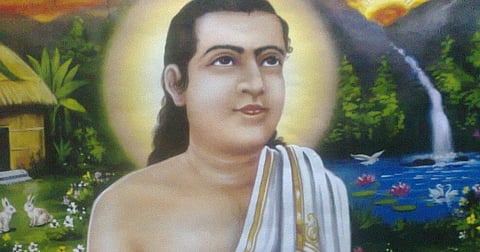
- Home
- Live Blog
- Breaking News
- Top Headlines
- Cities
- NE News
- Sentinel Media
- Sports
- Education
- Jobs

Pranjal Dutta
(The writer is Assistant Professor & HoD, Department of English, Sarupathar College, Golaghat and can be reached at pranjalduttaspr@gmail.com)
Religion denotes man’s faith and creed concerning his vital relations to this mysterious universe and his duty and destiny here. The founder of a religion serves as a light of intellect — a light kindled in darkness. He is a harbinger sent into the world with tidings from the Infinite.
Sankardeva came like many other prophets who had come before him and preached the message of humanity. His religion, for the Assamese, is like a rebirth and transformation from darkness into light and has been the religion and guiding force for the followers for the last six centuries. This Neo-Vaishnava “friend, philosopher and guide” and the doyen of Assamese culture has served as a beacon light for the masses.
The Neo-Vaishnavite religion propagated by Mahapurush Srimanta Sankardeva was the outcome of his wide experiences that emanated from various sources. In 1481, Sankardeva went on a pilgrimage to northern India where he spent several years visiting various Tirthas (Hindu holy places) and temples acquiring many dogmas that prevailed at that time. He was aware of the relevance of the Neo-Vaishnava movement growing in various parts of India and when he came back to his native land he directed his endeavours towards the formulation of the doctrines of his own form of Vaishnavism, namely, Eksaran Naamdharma. Sankardeva along with his staunchest disciple Madhavdava propagated his faith among the masses and within a short period of time, this new religion attained an all-pervasive nature. Eksaran Naamdharma has three aspects: Eksaran, Satsanga and Naama. Eksaran means seeking solace from one God, Satsanga denotes an assembly of Bhaktas (followers) for obeisance while Naama refers to chanting as a means of prayer. It forbids elaborate rituals and worship of idols while advocating an austere lifestyle for the Bhaktas (followers). Naama was considered to be sufficient for the common people because it could be performed by the high and the low. Sankardeva reduced rituals to the minimum and emphasized on prayer through community chanting in private prayer-rooms called ‘Kirtanghars’ and congregation halls called ‘Naamghars’. Over a period of time, the Naamghars grew to be centres of every activity of the village: it was like a club where people gathered in the evening, it was the theatre where classical dramas were staged, it was the court where misconduct was adjudged and it was the place for discussion on various affairs of the village.
The Eksaran Naamdharma propagated by Sankardeva has been able to unify people from all walks of life, from the aristocrats to the poor and downtrodden, into one spiritual fraternity and thereby achieved a cultural synthesis. In Sankardeva’s religion the essence of democracy, as well as the spirit of socialism, can easily be traced. Every individual was considered equal in his religion and neither caste nor class was taken into account while inducting anyone into the faith. The prayer service and the distribution of Maahprasad (offerings to the Almighty) could be done by anyone within the circle of Bhaktas. Through such an egalitarian philosophy Sankardeva was able to bring about the concept of equality among mankind and thus weed out caste-related differences.
When Eksaran Naamdharma spread like a wildfire, it raised many an eyebrow of the Brahmins who foresaw an end to their dominance. The Brahmins plotted conspiracy against Sankardeva and coaxed the Ahom ruler Suhungmung also known as Dihingia Raja to take action against the reformist movement. Thus Srimanta Sankardeva was thus forced to flee downstream and seek the safety offered by the Koch kingdom of Naranarayana in western Assam. King Naranarayana retained an open mind towards the new religion and his brother Chilarai became an ardent admirer of Sankardeva. The Brahmins were again being afraid of Sankardeva’s growing popularity poisoned the mind of the king against Sankardeva, but Sankardeva so enamoured the king with his logic and sanctity that the king became his lifelong patron.
During his undisturbed life at Chunpora (present-day Barpeta town), Sankardeva composed almost all his major literary works including the ‘Kirtan Ghosa’, an adaptation of ‘Bhagavatpurana’, the doctrinal treatise ‘Bhakti Ratnakar’ and such plays as Paarijat Harana, Kaliya Daman, Rukmini Haran and Keli Gopal. Sankardeva composed about two- hundred-and-forty Borgeets (written in the Brajavali dialect), but a fire destroyed them all and only about thirty-four of them could be retrieved from memory. Sankardeva, much saddened by this loss, gave up writing borgeets and asked Madhavdeva to write them instead.
The Neo-Vaishnavite movement brought about a cultural revolution in the Brahmaputra valley apart from playing a significant role in unifying the people and imbuing in them a catholic sensibility. The moral standards set at the naamghars and xattras rescued the society from the depravity of earlier days and ushered in cultural renaissance along with religious reform. The xattras established by the disciples of Sankardeva have become the hubs of cultural activities, where classical music, dance and drama were cultivated. The Neo-Vaishnavites also gave birth to a distinct Assamese school of painting where holy books were enlivened by colourful paintings. They exploited the modes of the song, dance and drama with a view to explaining and popularizing the new religion. In this way, they could touch the minds and hearts of the common people. The rendering of Sanskrit and Vaishnavite treatises into vernacular as well as their original compositions created a body of literature which resulted in bringing about a literary movement apart from developing Assamese prose. The Ankiyanaats composed by them were immensely popular and gave rise to a vibrant theatrical movement. Their musical compositions formulated a culture of classical music and they left behind a rich legacy of classical dancing in the Xattriya dance form.